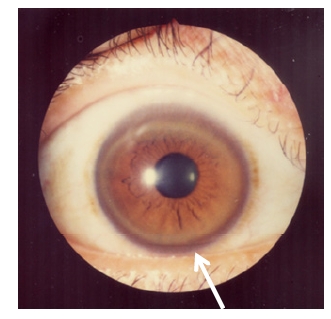Wilson disease (hepatolenticular degeneration) is an autosomal recessive disorder caused by various mutations in the ATP7B gene, which regulates copper transport within hepatocytes. Dysfunction of this transport mechanism leads to abnormal copper accumulations in the liver, brain, eyes, and other organs, with consequent major and variably expressed hepatic, neurologic, and psychiatric disturbances. Liver involvement may manifest as hepatitis, liver failure, or cirrhosis, while basal ganglia involvement causes the extrapyramidal signs. Most patients are diagnosed between the ages of 5 and 35 years (mean: 13 years). Diagnosis is established if the patient has low plasma ceruloplasmin, corneal deposits of copper (Kayser-Fleischer rings), and elevated copper levels in the urine. However, other tests are often needed since not all patients will have all these findings. The prognosis is good for patients without advanced liver disease and for those who are treated with the chelating agents penicillamine or trientine. Untreated Wilson disease is ultimately fatal, with patients dying from cirrhosis, acute liver failure, or complications due to progressive neurologic disease.
Last updated: May 19, 2025
Wilson disease Wilson disease Wilson disease (hepatolenticular degeneration) is an autosomal recessive disorder caused by various mutations in the ATP7B gene, which regulates copper transport within hepatocytes. Dysfunction of this transport mechanism leads to abnormal copper accumulations in the liver, brain, eyes, and other organs, with consequent major and variably expressed hepatic, neurologic, and psychiatric disturbances. Wilson Disease usually presents in children and young adults. It manifests, but not exclusively, between 3–55 years‐old (with a small minority presenting > 40 years of age). Manifestations are primarily hepatic, neurologic, and psychiatric and may include:[7,8]

Kayser-Fleischer ring: corneal copper deposition
Image: “Kayser-Fleischer rings” by Bentham Science Publishers, 2012. License: CC-BY-2.5Clinical presentation of Wilson disease Wilson disease Wilson disease (hepatolenticular degeneration) is an autosomal recessive disorder caused by various mutations in the ATP7B gene, which regulates copper transport within hepatocytes. Dysfunction of this transport mechanism leads to abnormal copper accumulations in the liver, brain, eyes, and other organs, with consequent major and variably expressed hepatic, neurologic, and psychiatric disturbances. Wilson Disease: ABCD
Management may vary depending on practice location. The following information is based on US and European literature and guidelines for adult patients Patients Individuals participating in the health care system for the purpose of receiving therapeutic, diagnostic, or preventive procedures. Clinician–Patient Relationship.
Treatment requires lifelong pharmacotherapy.
| Medication | Typical dose (adults) |
|---|---|
| Penicillamine Penicillamine 3-mercapto-d-valine. The most characteristic degradation product of the penicillin antibiotics. It is used as an antirheumatic and as a chelating agent in wilson’s disease. Wilson Disease | |
| Trientine Trientine An ethylenediamine derivative used as stabilizer for epoxy resins, as ampholyte for isoelectric focusing and as chelating agent for copper in hepatolenticular degeneration. Antidotes of Common Poisonings | |
| Zinc Zinc A metallic element of atomic number 30 and atomic weight 65. 38. It is a necessary trace element in the diet, forming an essential part of many enzymes, and playing an important role in protein synthesis and in cell division. Zinc deficiency is associated with anemia, short stature, hypogonadism, impaired wound healing, and geophagia. It is known by the symbol zn. Trace Elements acetate | 50 mg 3 times daily |
Liver transplantation Liver transplantation The transference of a part of or an entire liver from one human or animal to another. Hepatocellular Carcinoma (HCC) and Liver Metastases may be required in severe cases, such as fulminant liver failure Liver failure Severe inability of the liver to perform its normal metabolic functions, as evidenced by severe jaundice and abnormal serum levels of ammonia; bilirubin; alkaline phosphatase; aspartate aminotransferase; lactate dehydrogenases; and albumin/globulin ratio. Autoimmune Hepatitis or decompensated liver Liver The liver is the largest gland in the human body. The liver is found in the superior right quadrant of the abdomen and weighs approximately 1.5 kilograms. Its main functions are detoxification, metabolism, nutrient storage (e.g., iron and vitamins), synthesis of coagulation factors, formation of bile, filtration, and storage of blood. Liver: Anatomy disease despite medical therapy.